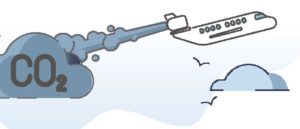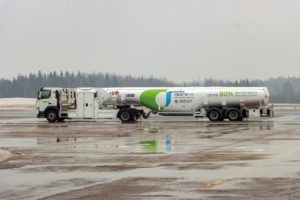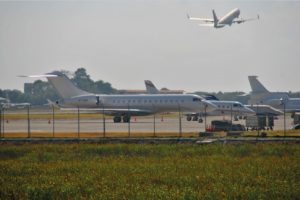Words by Alex Joseph
The need to reduce emissions and help efforts to stave off climate change presents the greatest challenge to the business aviation sector over the next decade. Procrastination on action to reduce aviation’s environmental impact is quickly becoming inadequate for consumers and the planet. In addition, an increasingly hostile legislative environment awaits those who fail to act.
Whilst aviation currently only contributes to 3% of global emissions, this could reach as high as 22% by 2050. As a result, carbon taxes have already been adopted by major economies and are likely to expand. French politicians are even considering an outright ban or heavy tax on private aviation. The introduction of such legislation would be a watershed moment for business aviation.
The widespread adoption of electric aircraft over the next decade is unlikely due to the inferior energy density of batteries compared to jet fuel. There is also criticism of carbon offsetting schemes in terms of their regulation, transparency and effectiveness. It can seem improving business aviation’s environmental credentials is an almost impossible task. However, while the strategy for private aviation is complex and needs regular revision for those who wish to make a positive impact – it can be done with time and investment.
In the present, there are two principle contenders to reduce and offset emissions for the aviation industry, Sustainable Aviation Fuel (SAF) and external carbon offsetting schemes. Each has its own complications, benefits and downsides. Navigating these properly is crucial to achieving bona fide success with offsetting.
Confusing emissions

Greenwashing, attempting to give the appearance of caring for the environment while not delivering effective results, is the ultimate sin in the offset industry.
Much of the confusion around carbon offsetting centers on defining the term in relation to the actions taken to achieve it, and the language used to describe it. Kennedy Ricci, president of 4Air, a Boston, USA-based firm that specializes in climate solutions for the aviation industry has witnessed the consequences of this confusion first-hand.
He has often had to correct marketing materials from clients who attempt to claim “Carbon Zero” status when in fact they have only achieved “Carbon Neutrality”. He describes this as an inevitable part of an “offset journey” that 4Air helps its clients through.
Sebastien Lacube, head of voluntary carbon markets at environmental consultancy Azzera notes similar issues. He says, “We usually interact with clients that have no idea of what a carbon offset is. We have to start from scratch and usually explain what greenhouse gas emissions are. We also often encounter misconceptions about distinctions between removal and avoidance.”
Most business aviation industry insiders agree that to deliver real change a major part of the solution must be to start with better education and training within the sector on the nuances behind carbon footprints and offsetting.
Standardizing offsets
The most pressing issue after education is to ensure that once emissions are calculated, the offset achieves what it sets out to. No project is guaranteed success – trees planted can die. Renewables schemes might falter or go over budget.
Checking scheme certifications can be a helpful step in ensuring that an offset budget is spent wisely. Azzera’s Sebastien Lacube believes that Verra, followed by Gold Standard are the two best certification bodies. Older, Clean Development Mechanisms are now largely avoided due to outdated methodologies. To ensure a fair spread of risks, Lacube recommends developing a portfolio approach when investing in offset schemes, with a mix of lower risk and higher risk projects. Also key is avoiding practices such as the trade of carbon credits in schemes that were already set to go ahead, which can lead to multiple companies claiming offset against the same carbon credit. To build greater trust in carbon offseting going forward, Anant Jain, head of carbon compliance and SAF at Azzera notes there needs to be greater standardization for the quality of schemes.
“The Voluntary Carbon Market Initiative aims to increase the credibility and standards for best practice within the market,” says Jain. “Yet there is no straightforward guidance from them as to what is good quality and what is not. I expect this to improve.”
A good example of this uncertainty within the offset industry is the debate around forest protection schemes, which should not be confused with planting new forest. Forest protection schemes have been criticized because they are often measured against a hypothetical scenario, namely deforestation and degradation. Nevertheless, some schemes that use the UN-back framework REDD (Reducing Emissions from Deforestation and forest Degradation) still achieve high scores when measured by the Sylvera carbon intelligence research platform.
This shows that research is vital before adding a scheme to your portfolio and that consulting experts is necessary to achieve the best results. Nevertheless, when conducting your own research, evidence of thorough and wide-reaching carbon accounting for every activity, alongside certification from leading bodies indicate that a scheme is more likely to be trustworthy.
Discussions over new standards are occurring all the time and it is likely that they will become more stringent and easier to understand for consumers. The EU Emissions Trading Scheme for instance re-constituted in 2021 and further revisions will follow.
Understanding SAF

Sustainable Aviation Fuel (SAF) is one of the newest tools in the offset space. Made from waste-products it still technically constitutes an offset scheme, although there is evidence that SAFs contain fewer impurities and therefore also reduce non-carbon emissions such as sulphur dioxide and particulate matter. Given the difficulty of switching long-haul aviation to electric or hydrogen, the International Air Transportation Association (IATA) estimates that by 2050, SAF will still serve around 65% of global aviation fuel demands.
The reduction in net carbon emissions from SAF is because its organic feedstocks have sequestered CO2 from the atmosphere to grow in the first place, contributing to a degree of neutrality. In its current iteration, SAF is principally made from a feedstock of tallow, used cooking oils and greases. The issue is that these waste products are finite.
However, like all offset schemes caution must be exercised because the worst schemes can do more harm than good. Due to the deforestation associated with its production, fuels based on Palm Oil from certain regions can be more carbon intensive than conventional jet fuel. It is for these reasons that EU SAF under the Renewable Energy Directive (RED II) can be seen as more sustainable than US SAF, due to the prohibition of re-directing food-based feedstocks under RED II.
Certifications are important in defining what constitutes as sustainable for SAFs and what does not. Knowledge of the lists of which fuels are endorsed by bodies such as Corsia (Carbon Offsetting and Reduction Scheme for International Aviation) and also by the EU Emissions Trading Scheme are key if buyers are to avoid purchasing fuel that fails to offset.
Yet again, not all certification bodies are created equal and reporting still needs to improve. Jain says, “There is a lack of transparency in general. The International Sustainability and Carbon Certification audits feedstocks for producers and lists the certificates and reports on their portal.
“However, if you go through the feedstocks, attributes are not separately tagged to each batch of fuel created. It simply lists all the feedstocks that the producer aims to utilize and their region of origin.”
Furthermore, the range of feedstocks available to SAF producers needs to grow if it is to meet rapidly rising demand. Costs as a result per metric tonne of offset are far higher, ranging from US$450-750 in comparison with US$20-30 per tonne for high end Ocean Carbon offset projects. Even in the highest two tiers of 4Air’s offset schemes, SAF only plays a small contributing role in the program. Whilst this all sounds expensive, 4Air’s Level 3 and 4 schemes are only likely to account for up to 2% and up to 3% of the total flight cost respectively for a standard flight – within the range of what can be passed onto clients.
Hopefully, change is on its way. Ricci estimates that a new second generation of SAF “will come online around 2024–2025, when we will see second generation feedstocks and much wider availability of supply.” However, this is not without its limitations.
Jain says, “emissions related to transportation of the fuel are not really included in the final calculation of carbon intensity” and that the current maximum permissible blend is currently only 50%, although this too could change.
Going forward, as new standards are implemented and premium carbon capture schemes hit the market, the quality of schemes will likely increase and so too will their accessibility – but Jain warns that aviation companies will need to increase their own knowledge if they are to make the most of these improvements and push carbon credits further.






